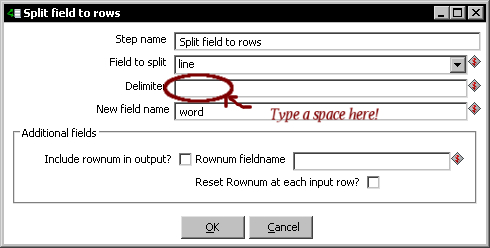Let's suppose, you have some plain text files, and you want to know what is said in them. You don't want to read them, so you decide to count the times that words appear in the text, and see the most frequent ones to get an idea of what the files are about.
Note
Before starting, you'll need at least one text file to play with. The text file used in this tutorial is named smcng10.txt and is available for you to download from the Packt website.
Let's work:
Create a new transformation.
By using a Text file input step, read your file. The trick here is to put as a separator a sign you are not expecting in the file, for example
|. By doing so, the entire line would be recognized as a single field. Configure the Fields tab by defining a single string field namedline.From the Transform category of step, drag to the canvas a Split field to rows step, and create a hop from Text file input step to this new step.

With...



